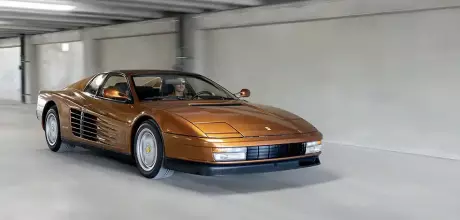1984 Ferrari Testarossa
You don’t have to be …to run a Ferrari Testarossa in London every day, but it helps –as does the car being a later variant, re-coloured in Nocciola.
Words James Elliott
Photography Paul Harmer
FERRARI TESTAROSSAA supercar used daily around London streets
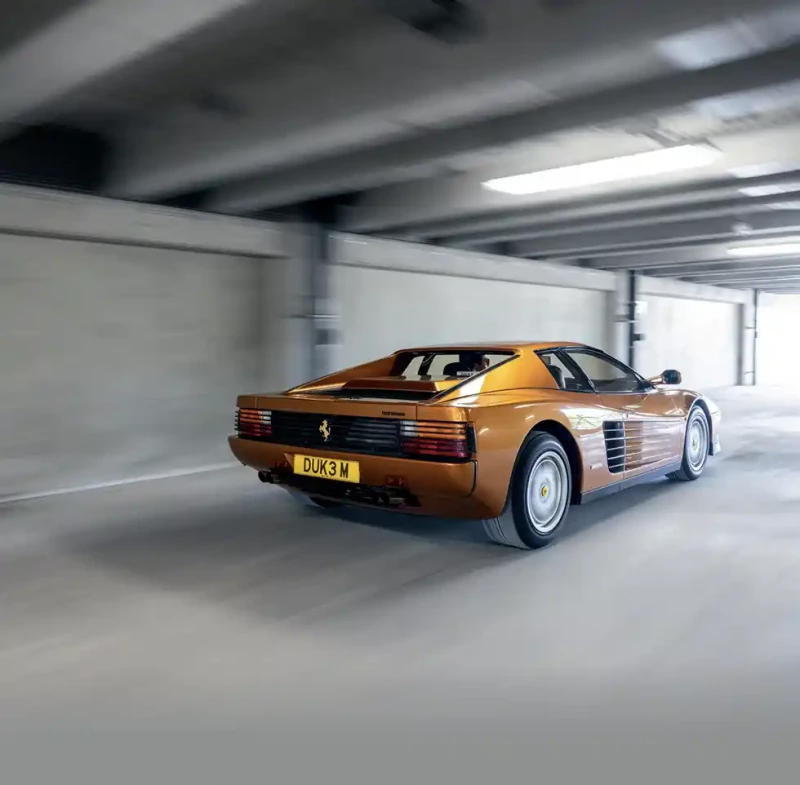
Looks can be deceptive. Was there ever a more flamboyant and extrovert Ferrari than the Testarossa to look at, yet was there ever a more docile and practical 12-cylinder Ferrari supercar to live with? Perhaps that was its problem. Pininfarina’s sweeping lines, the triangular shape, side strakes, fi ns, louvres, a metal cage over the tail-lights, pop-up headlights: it is extravagance and swagger in metal, pure bravado; braggadocio, even. Then there is the 12-cylinder engine, officially a 180º V12 (we shall just call it a flat-12 from here on), promising Donner und Blitzen but deemed to deliver Dancer and Prancer. And for years, most people – especially in the UK, for which this car was signally not designed – thought that a bad thing. They were wrong, of course. They just didn’t understand. They can’t be blamed, the Testarossa was easily misunderstood, especially in compact Britain where driving opportunities are compressed and pure continent-crossing GTs are alien fare. This Ferrari looked every inch the supercar, its performance stats were those of a supercar, but in its soul it simply wasn’t one. It wasn’t sufficiently highly strung. It had air-con.
Introduced to replace the 512BB in 1984, the Testarossa was longer, wider and lighter (yet at 1506kg it was considerably heftier than its period rivals, barring the brutalist Aston Martin Vantage), but soldiered on until 1991 when the 512 tag (first the 512TR, then the F512 M) was reintroduced for its later incarnations. It was powered by the same fuel-injected quad-cam 4943cc 12-cylinder as the preceding 512 but with four valves per cylinder, offering 50bhp more (at 390bhp) and over 180mph. Its evolution was principally defined by wing-mirrors and wheel-bolts, the purest monospecchio monodado having only one of each until twin mirrors arrived in 1988, a year aft er the F40-esque spinners had given quarter to a more traditional five-bolt pattern.
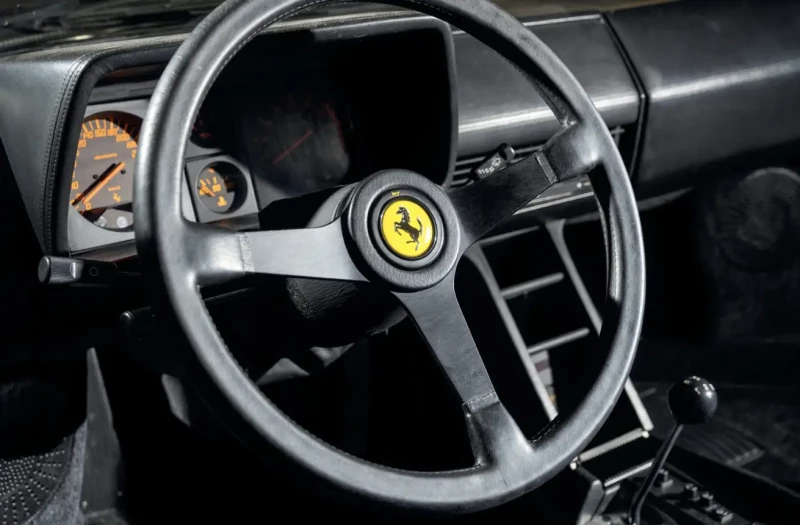
As well as design tweaks and bigger wheels (16in and 18in), the changes brought in for the 512 in 1991 included a lowered engine and transaxle, improved diff ’ and injection, plus a higher compression ratio. Th e 1994-1996 run-out 512 M (Modificata) lost the pop-ups, but gained NACA ducts and split-rims for maximum menace.
The Testarossa was far from cheap at £60k-plus new, but achieved sales of almost 10,000 cars. Today they are covered by a broad price band of roughly £100,000 to 200,000 and are creeping up, yet still criminally undervalued if you compare prices with contemporary rivals’.
The fact that this Testarossa is left-hand drive and in Rosso Corsa (we’ll come to that!) with black interior, twin mirrors and five-bolt wheels, on paper makes it the least distinguished of the breed – white with tan interior, monospecchio and monodado is the holy grail, right-hand drive a bonus – but to Octane the fact that it has covered 24,000km since acquiring itself a new owner just two years ago makes it one of the most desirable and interesting.
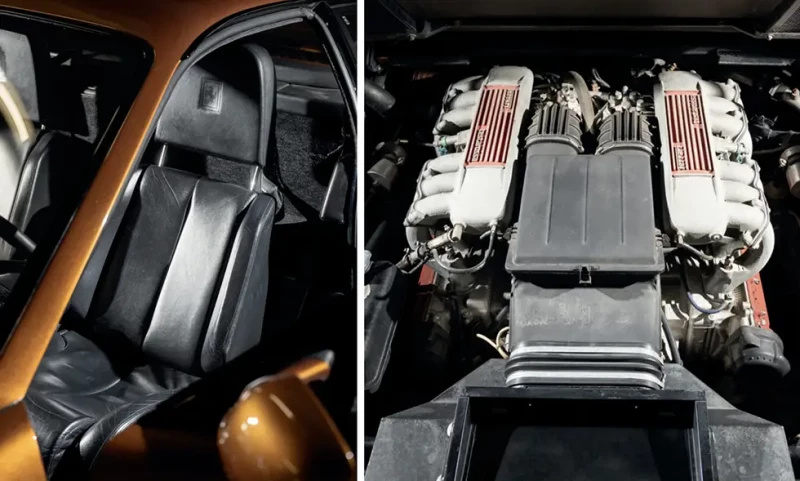
I imagine you have some questions. No, it’s not a wrap (technically), yes it is a Ferrari colour, no it wasn’t on any Testarossas (this is Daytona-era Nocciola), yes it is that car that seems to be omnipresent on social media, fast becoming one of the most photographed classics in London. Except for that Bristol and those Citroëns. There’s a reason for this. It is owned by Merlin McCormack, at 30 one of the thrusting young blades of the classic car world and boss of Duke of London, which has added purpose to Brentford in West London.
The Ferrari was an intriguing choice for someone brought up surrounded by everything from hot rods and yank tanks to Bristols and a BMW 635 High-Line E24. He explains: ‘I had a Bburago model when I was five and I was obsessed with it, and nothing has changed my perspective since. Like the F40, it’s one of very few Ferraris that is immune from any Ferrari stigma.
‘Just before my 28th birthday the business was going well and I thought I could afford one, so I impatiently visited every example on sale in the UK within my budget. There were five. Georgia [Peck, of Aubrey Peck Automotive, and Merlin’s girlfriend of six years] and myself were on our way home from seeing one in Birmingham; she was driving and I was scrolling and this popped up on eBay at Autofficina, ironically just 20 minutes from where we lived, so we arranged to go straight there before they closed for the evening.
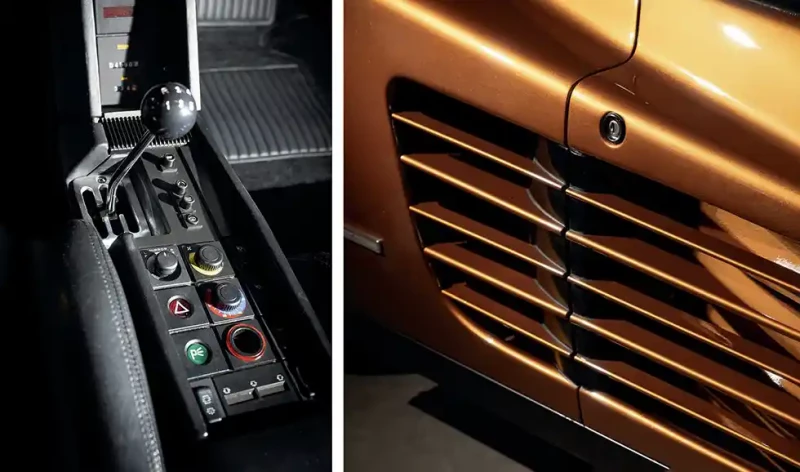
‘I made an offer, which they turned down, but when driving home Georgia told me what an idiot I was to walk away and we went straight back. It came with a warranty and, to be fair, the guys in Epsom stood by a lot of warranty work, which was crucial to getting it where I wanted it.’ The 1989-built car had been delivered new to Germany, spent a decade in Japan until it came to the UK in 2012, and then was in single UK ownership doing 500km a year until Merlin bought it. There was, however, a significant problem: ‘I hate red Ferraris! I bought it in March 2022 thinking I would run it for the summer and probably sell it in September, but by then I had fallen for it and knew I was going to keep it, so had to change the colour.’
Yet not white, Merlin’s preferred Testarossa colour, ‘because I could buy one of those’ but Nocciola, a firm Maranello favourite applied in myriad hues to many Ferraris, but never the Testarossa. Hence, Litchfield Motors worked its magic with a PPS (paint protection system). This differs from a wrap in that it’s a film over the existing paint that’s then sprayed in the traditional way in a booth, all your detachables off. This apparently gives a more thorough, longer-lasting job but it still peels off and costs about half the price of a respray. All I can say is that you wouldn’t know it wasn’t the car’s ‘proper’ paint, yet, should he need to raise cash in a hurry, Merlin has the comfort of knowing the original Rosso Vendere is still underneath. Pininfarina declared that the Testarossa was designed to be red, after all.
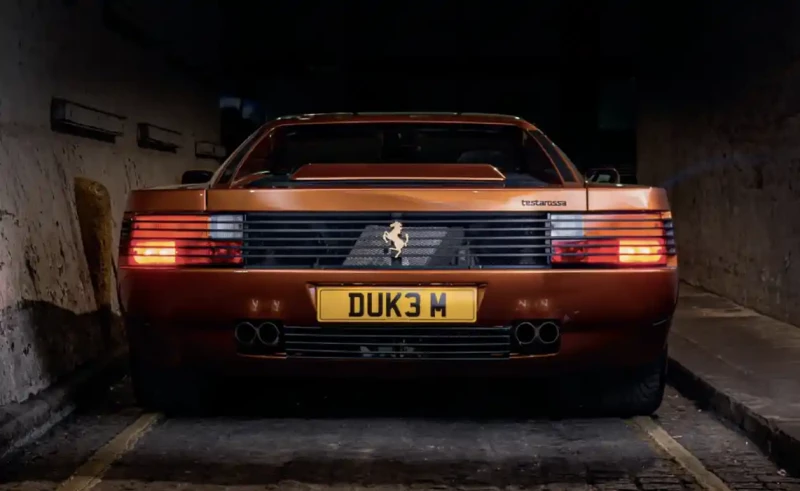
Merlin’s next priority was to turn the Testarossa into a daily driver, which takes deep pockets and a certain attitude. This one: ‘It’s a f***ing car. It’s not even that old. And because it is one of the less desirable later ones, it is actually a far more developed car with a proper diff’, five-bolt wheels and a proper fuel system. There is nothing left to be scared of.’ Having spent ‘a small fortune’ on getting it to a point where he can trust it, Merlin has certainly made good on his intentions. As well as regularly being spotted in Central London – there are four fans, it’ll sit all day without getting hot – it drove to Rétromobile in Paris straight after acquisition, has blasted across Europe many times, splashed through flash floods in Scotland and, when Octane photographed it, only the previous day had driven back from Italy.
‘We drove down to a wedding overnight – leaving London at midnight and arriving in Portofino the following afternoon – and did 2500km over the weekend. We sat at triple figures [km/h… we’ll presume] average and the car just glides, doing 20mpg. After the wedding we called in at Villa d’Este, then did a nine-hour door-to-door sprint to get home sharing the driving. It’s Georgia’s favourite car of ours and she uses it as much as I do. ‘I have got so used to using it now that nothing really fazes me about it. We’ve driven it in sun, snow and hail, city centres and the middle of nowhere, motorways and twisties and I’ve never once thought “I wish I was in something else.” Which is unusual because I’m someone who chops and changes cars a lot because they are like a savings account for me and sometimes I need to cash out. This is the only car I’ve owned where I can happily say – on the record! – that I’d love to keep it forever. I’ve built up such a bond with it.’
London presents a different challenge, one where Merlin admits to kerbing the wheels a few times in width restrictors, largely because the rear track is a whopping 14cm wider than the front. Just imagine the mental gymnastics of parallel-parking that to a city kerb.
There’s nothing as glamorous as The City or sweeping French D-roads for me. The A4 heading west out of Brentford is a poor substitute for the Route Napoleon or the Grande Strada delle Dolomiti, but even among the legions of white vans streaming out of London this Ferrari shimmers and shines.
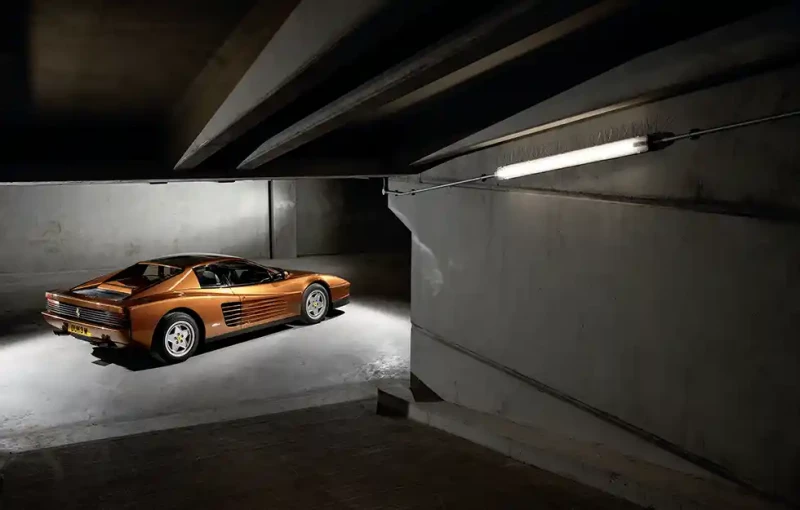
Because I am short, there is an unexpected generosity of space as well as light inside the Testarossa that you don’t expect from the exterior; it isn’t even that difficult to get in and out. The seats are comfortable, the dials simple and split between the binnacle and the centre console. The steering wheel is far more slender than you might expect given the chunkiness of the era. Visibility is excellent, not Giugiaro glasshouse excellent, of course, but compared with a Countach…
Turn the key to fire it up and the engine is far from intrusive as it struggles to find its ideal idle, always seeming to hunt a little. It sounds great, but you really need to be at 3000rpm-plus to enjoy it as those outside the car can, especially with its raucous Japanese MS Racing exhaust with adjustable valve (set to max, naturally).
The pedals are wildly offset to the right, but you soon get used to that, as you do skipping second until the gearbox temperature is well up. Once it is up to heat, however, it is sublime.
This particular Testarossa is loose but not sloppy, perfect to jump in and drive and in most respects it is no more tricky or uptight than any 1970s sports car. The smoothness of the injection really sets it apart from earlier Ferraris with their guttural spitting and spluttering and its long-leggedness is eye-opening, the engine starting to sing from as little as 3000rpm, but really coming alive and belting it out from 5000rpm all the way to the redline at 6800. The brakes came in for a lot of stick, but they are fine – not stand-out good but not catastrophically bad either.
The twin-plate clutch, though… Its owner was recently bitten with a £3k bill after burning one out reversing up a steep Swiss driveway; we are politely asked not to ride or slip it. That’s fine when it’s cold, when you can simply put it in first and it will creep like an auto before you apply the throttle. When it is hot and wants to stall without revs, it is a bit trickier. The steering is light and precise and grip is sensational even on now-ageing Michelins. They were fresh when Merlin bought the car, and need a change now, which will set him back a couple of grand. This is not a car for jinking along country B-roads, though. It probably could, but why would you want to when that is the métier of smaller, lighter, less powerful beasts. No, when sitting low in your Testarossa every vista incites a mental filter of tree-lined Routes Nationales. Not the autoroute slog down to Italy, but the sweeping single-laners where you can punch past trucks and enjoy every yowl of delight from that magnificent engine. Was this car wide in period? Undoubtedly, but today it feels less so, and two mirrors set lower than the monospecchio make a world of difference in traffic.
After the drive, it’s time for our portrait of Merlin with the car. He glides onto the ‘set’ like it’s the red carpet at the Oscars, settles effortlessly on those wavy sideskirts of the car, loose-fitting shirt unbuttoned à la 1970s, gold-rimmed shades in hand and a sweep of luxuriant hair like one of those photos on the wall of your barber’s. Appropriately, considering the car, he looks like he has walked straight off the set of Miami Vice, apparently oozing self-confidence. Braggadocio, even. But then he shudders and modestly mumbles ‘I hate having my photo taken.’ Despite all the online evidence to the contrary, I believe him. After all, looks can be deceptive.
‘WHEN OCTANE PHOTOGRAPHED IT, ONLY THE PREVIOUS DAY IT HAD DRIVEN BACK FROM ITALY’
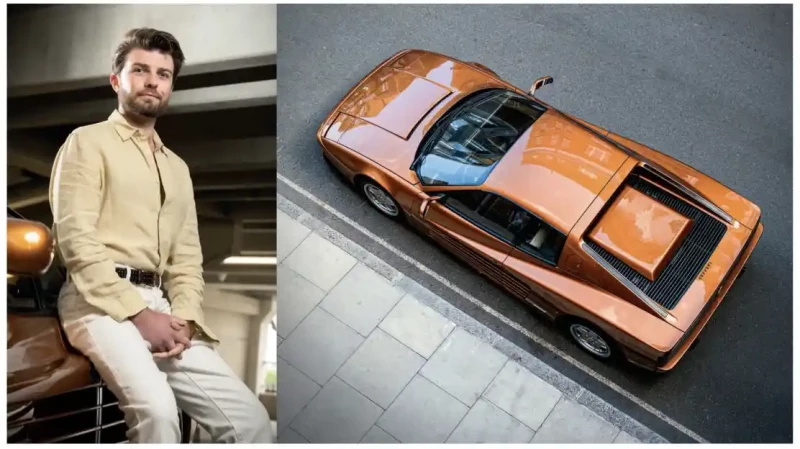
Left, from top Comfortable interior is adequate for space but does not reflect exterior dimensions; longitudinal flat-12 is a jewel that really comes alive at about 4500rpm.
TECHNICAL DATA 1984 Ferrari Testarossa
- Engine 4943cc flat-12, DOHC per bank, Bosch K-Jetronic fuel injection
- Max Power 390bhp @ 6300rpm
- Max Torque 362lb ft @ 4500rpm
- Transmission Five-speed manual transaxle, rear-wheel drive
- Steering Rack and pinion
- Suspension Front and rear: unequal-length double wishbones, coil springs, telescopic dampers, anti-roll bar
- Brakes Vented discs
- Weight 1506kg
- Top speed 181mph
- Acceleration 0-60mph 5.2sec
Above left Testarossa offers a comfortable GT driving position, even if clutch is heavy and pedals are well offset to the right. Steering wheel and gearlever are wonderful.
Left Nocciola was not originally available on Ferrari’s Testarossa, and this striking iteration – selected from myriad hues – came from the 365 GTB/4 Daytona.


